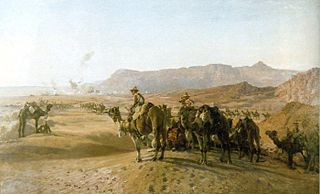
The Battle of Magdhaba took place on 23 December 1916 during the Defence of Egypt section of the Sinai and Palestine Campaign in the First World War. The attack by the Anzac Mounted Division took place against an entrenched Ottoman Army garrison to the south and east of Bir Lahfan in the Sinai desert, some 18–25 miles (29–40 km) inland from the Mediterranean coast. This Egyptian Expeditionary Force (EEF) victory against the Ottoman Empire garrison also secured the town of El Arish after the Ottoman garrison withdrew.
The Australian Mounted Division originally formed as the Imperial Mounted Division in January 1917, was a mounted infantry, light horse and yeomanry division. The division was formed in Egypt, and along with the Anzac Mounted Division formed part of Desert Column, Egyptian Expeditionary Force in World War I. The division was originally made up of the Australian 3rd Light Horse Brigade, the reconstituted 4th Light Horse Brigade, and two British yeomanry brigades; the 5th Mounted Brigade and 6th Mounted Brigade.
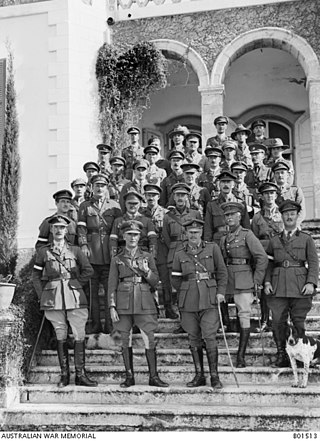
The Desert Mounted Corps was an army corps of the British Army during the First World War, of three mounted divisions renamed in August 1917 by General Edmund Allenby, from Desert Column. These divisions which served in the Sinai and Palestine Campaign had been formed by Australian light horse, British yeomanry, and New Zealand mounted rifles brigades, supported by horse artillery, infantry and support troops. They were later joined by Indian cavalry and a small French cavalry detachment.

The First Battle of Gaza was fought on 26 March 1917 during the first attempt by the Egyptian Expeditionary Force (EEF), which was a British Empire military formation, formed on 10 March 1916 under the command of General Archibald Murray from the Mediterranean Expeditionary Force and the Force in Egypt (1914–15), at the beginning of the Sinai and Palestine Campaign of the First World War. Fighting took place in and around the town of Gaza on the Mediterranean coast when infantry and mounted infantry from the Desert Column, a component of the Eastern Force, attacked the town. Late in the afternoon, on the verge of capturing Gaza, the Desert Column was withdrawn due to concerns about the approaching darkness and large Ottoman reinforcements. This British defeat was followed a few weeks later by the even more emphatic defeat of the Eastern Force at the Second Battle of Gaza in April 1917.

The Third Battle of Gaza was fought on the night of 1–2 November 1917 between British and Ottoman forces during the Sinai and Palestine Campaign of World War I and came after the British Egyptian Expeditionary Force (EEF) victory at the Battle of Beersheba had ended the Stalemate in Southern Palestine. The fighting occurred at the beginning of the Southern Palestine Offensive, and, together with attacks on Hareira and Sheria on 6–7 November and the continuing Battle of Tel el Khuweilfe, which had been launched by General Edmund Allenby on 1 November, it eventually broke the Gaza-to-Beersheba line defended by the Yildirim Army Group. Despite having held this line since March 1917, the Ottoman Army was forced to evacuate Gaza and Tel el Khuweilfe during the night of 6–7 November. Only Sheria held out for most of the 7 November before it too was captured.
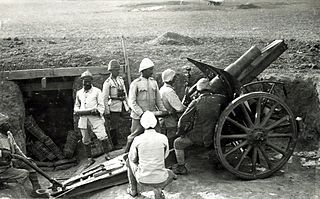
The Sinai and Palestine campaign of the Middle Eastern theatre of World War I was fought by the Arab Revolt and the British Empire, against the Ottoman Empire and its Imperial German allies. It started with an Ottoman attempt at raiding the Suez Canal in 1915, and ended with the Armistice of Mudros in 1918, leading to the cession of Ottoman Syria.

The Raid on the Suez Canal, also known as Actions on the Suez Canal, took place between 26 January and 4 February 1915 when a German-led Ottoman Army force advanced from Southern Palestine to attack the British Empire-protected Suez Canal, marking the beginning of the Sinai and Palestine Campaign (1915–1918) of World War I (1914–1918).
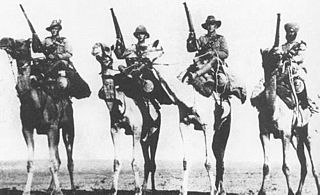
The Imperial Camel Corps Brigade (ICCB) was a camel-mounted infantry brigade that the British Empire raised in December 1916 during the First World War for service in the Middle East.
The 10th Indian Division was an infantry division of the British Indian Army during World War I. It was formed in Egypt in December 1914 with three infantry brigades of Indian Expeditionary Force F. After taking part in the Actions on the Suez Canal, the division was dispersed as its brigades were posted away.

The 7th (Meerut) Division was an infantry division of the British Indian Army that saw active service during World War I.

The Imperial Service Troops were forces raised by the princely states of the British Indian Empire. These troops were available for service alongside the Indian Army when such service was requested by the British government. At the beginning of the 20th century, their total numbers were about 18,000 men.

The Battle of Katia, also known as the Affair of Qatia by the British, was an engagement fought east of the Suez Canal and north of El Ferdan Station, in the vicinity of Katia and Oghratina, on 23 April 1916 during the Defence of the Suez Canal Campaign of World War I. An Ottoman force led by the German General Friedrich Freiherr Kress von Kressenstein made a surprise attack on three and a half squadrons of the British 5th Mounted Brigade, which was widely scattered to the east of Romani. The mounted brigade had been ordered to the area to protect the new railway and water pipeline being built from Kantara on the Suez Canal, as this infrastructure extended out past the Canal's zone of defences into the Sinai Peninsula towards Romani. Kress Von Kressenstein's attack was completely successful, decimating the equivalent of little more than a regiment. On the same day, an associated Ottoman attack on Duidar, very close to the Suez Canal, failed when it met with strong British opposition.
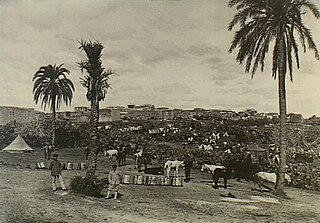
The Battle of Tulkarm took place on 19 September 1918, beginning of the Battle of Sharon, which along with the Battle of Nablus formed the set piece Battle of Megiddo fought between 19 and 25 September in the last months of the Sinai and Palestine Campaign of the First World War. During the infantry phase of the Battle of Sharon the British Empire 60th Division, XXI Corps attacked and captured the section of the front line nearest the Mediterranean coast under cover of an intense artillery barrage including a creeping barrage and naval gunfire. This Egyptian Expeditionary Force (EEF) victory over the entrenched Ottoman Eighth Army, composed of German and Ottoman soldiers, began the Final Offensive, ultimately resulting in the destruction of the equivalent of one Ottoman army, the retreat of what remained of two others, and the capture of many thousands of prisoners and many miles of territory from the Judean Hills to the border of modern-day Turkey. After the end of the battle of Megiddo, the Desert Mounted Corps pursued the retreating soldiers to Damascus, six days later. By the time an Armistice of Mudros was signed between the Allies and the Ottoman Empire five weeks later, Aleppo had been captured.
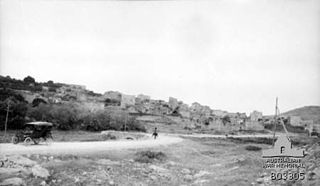
The Battle of Tabsor was fought on 19–20 September 1918 beginning the Battle of Sharon, which along with the Battle of Nablus formed the set piece Battle of Megiddo fought between 19 and 25 September in the last months of the Sinai and Palestine Campaign of the First World War. During the infantry phase of the Battle of Sharon the British Empire 60th Division, XXI Corps attacked and captured the section of the front line nearest the Mediterranean coast under cover of an intense artillery barrage including a creeping barrage and naval gunfire. This Egyptian Expeditionary Force (EEF) victory over the entrenched Ottoman Eighth Army, composed of German and Ottoman soldiers, began the Final Offensive, ultimately resulting in the destruction of the equivalent of one Ottoman army, the retreat of what remained of two others, and the capture of many thousands of prisoners and many miles of territory from the Judean Hills to the border of modern-day Turkey. After the end of the battle of Megiddo, the Desert Mounted Corps pursued the retreating soldiers to Damascus, six days later. By the time the Armistice of Mudros was signed between the Allies and the Ottoman Empire five weeks later, Aleppo had been captured.
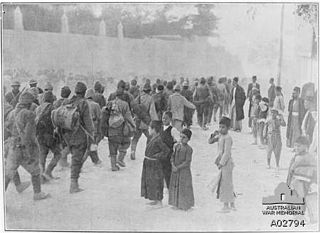
The Battle of Nablus took place, together with the Battle of Sharon during the set piece Battle of Megiddo between 19 and 25 September 1918 in the last months of the Sinai and Palestine Campaign of the First World War. Fighting took place in the Judean Hills where the British Empire's XX Corps attacked the Ottoman Empire's Yildirim Army Group's Seventh Army defending their line in front of Nablus. This battle was also fought on the right flank in the Jordan Valley, where Chaytor's Force attacked and captured the Jordan River crossings, before attacking the Fourth Army at Es Salt and Amman capturing many thousands of prisoners and extensive territory. The Battle of Nablus began half a day after the main Battle of Sharon, which was fought on the Mediterranean section of the front line where the XXI Corps attacked the Eighth Army defending the line in front of Tulkarm and Tabsor and the Desert Mounted Corps which rode north to capture the Esdrealon Plain. Together these two battles, known as the Battle of Megiddo, began the Final Offensive of the war in the Sinai and Palestine campaign.
Chaytor's Force named after its commander, Major General Edward Chaytor, was a composite division-sized force which served in the British Egyptian Expeditionary Force during the Sinai and Palestine Campaign of the First World War. The force of 11,000 men, consisted of a division headquarters, three mounted and one infantry brigades, four independent infantry battalions and four artillery batteries and was detached from the Desert Mounted Corps for deception operations.

The First Battle of Amman was fought from 27 to 31 March 1918 during the First Transjordan attack on Amman of the Sinai and Palestine Campaign of the First World War. The 60th (London) Division and the Anzac Mounted Division attacked the Ottoman garrison at Amman deep in enemy occupied territory, 48 kilometres (30 mi) from their front line, after capturing Es Salt and Shunet Nimrin. The Egyptian Expeditionary Force (EEF) was successfully counterattacked by Ottoman Empire forces forcing them to retreat back to the bridgeheads captured on the Jordan River.

The Second Battle of Amman was fought on 25 September 1918 during the Third Transjordan attack as part of the Battle of Nablus which together with the main Battle of Sharon form the major set piece offensive known as the Battle of Megiddo of the Sinai and Palestine Campaign in World War I. After cutting the road from Nablus to Es Salt on 22 September Chaytor's Force captured the bridge over the Jordan River at Jisr ed Damieh while units of the Seventh Army and remnants of the Eighth Army were still in retreating towards the bridge from the Judean Hills. Having cut this line of retreat, Chaytor's Force proceeded eastwards to attack and capture Es Salt, before riding on to attack and capture the Ottoman rearguard of the Fourth Army defending Amman. These British Empire victories of the Third Transjordan attack over Yildirim Army Group forces, followed two unsuccessful EEF attacks across the Jordan River in March and April 1918.

The Desert Column was a First World War British Empire army corps which operated in the Sinai and Palestine Campaign from 22 December 1916. The Column was commanded by Lieutenant General Philip W. Chetwode and formed part of Eastern Force. When Chetwode took command of Eastern Force after the Second Battle of Gaza, Harry Chauvel took command and oversaw the expansion of the column to three divisions.
The Structure of the Egyptian Expeditionary Force over the course of the First World War is shown below.

















